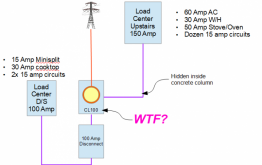svetz
Works in theory! Practice? That's something else
Another topic for your inner electrician....
UPDATE: It's bad data ... gigo .. the service meter is actually a CL-200... see the Crisis Averted post below...
The inspection for the new house for my mother-in-law listed an oddity. The service meter was 100 amps and just below that was a 100 amp disconnect. The oddity is that inside the house is a 150 amp load center. I thought the service was fairly small and toyed with the idea of having the meter changed out at some point to add on an elevator (she's 92).
Now that I've painstakingly traced all the wires from the circuit breakers I have learned the cursory inspection was all wet (in more ways than one, expecting an 1" of rain tomorrow after the 1" we had today and that storm is now called tropical depression 28). I found a second hidden load center in the downstairs area.
So, the guy we bought this off of was a retired fireman; I'm starting to think he liked fires.
So, it turns out it really looks like this:
I verified the wire gauges were correct for the 150 and 100 amp load centers out to the meter, but the problem is the service entrance is only 100 amps. The house on average probably pulls under 15 amps. But if the stove is on and the hot water is on and both ACs are on while running the dishwasher and somebody turns on the vacuum... do I get glow in the dark wires from the pole?
Anyway, has anyone ever had to deal with something like this? I imagine I just call the power company and ask them to change the service. If I have to bring the exterior up to code it'll cost some big $. When I got my netmeter replacement they didn't make me do it. Guess it depends on what the gauge is from the pole to the meter as to how ornery they'll get.
UPDATE: It's bad data ... gigo .. the service meter is actually a CL-200... see the Crisis Averted post below...
The inspection for the new house for my mother-in-law listed an oddity. The service meter was 100 amps and just below that was a 100 amp disconnect. The oddity is that inside the house is a 150 amp load center. I thought the service was fairly small and toyed with the idea of having the meter changed out at some point to add on an elevator (she's 92).
Now that I've painstakingly traced all the wires from the circuit breakers I have learned the cursory inspection was all wet (in more ways than one, expecting an 1" of rain tomorrow after the 1" we had today and that storm is now called tropical depression 28). I found a second hidden load center in the downstairs area.
So, the guy we bought this off of was a retired fireman; I'm starting to think he liked fires.
So, it turns out it really looks like this:
I verified the wire gauges were correct for the 150 and 100 amp load centers out to the meter, but the problem is the service entrance is only 100 amps. The house on average probably pulls under 15 amps. But if the stove is on and the hot water is on and both ACs are on while running the dishwasher and somebody turns on the vacuum... do I get glow in the dark wires from the pole?
Anyway, has anyone ever had to deal with something like this? I imagine I just call the power company and ask them to change the service. If I have to bring the exterior up to code it'll cost some big $. When I got my netmeter replacement they didn't make me do it. Guess it depends on what the gauge is from the pole to the meter as to how ornery they'll get.
Last edited:





